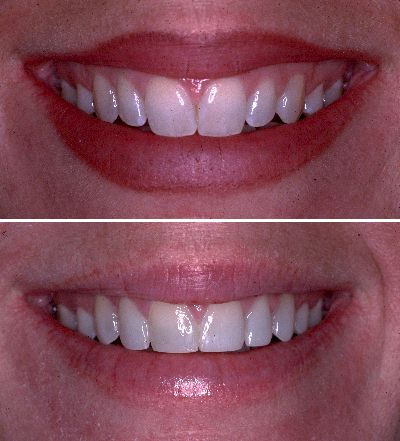Bonding

This Patient felt that her front teeth were too long. Upon further interviewing I also found out that she didn't like the shaper of her right lateral incisor as well as the rotation of her right central incisor. First we cosmetically contoured her front two central incisors, then we bonded her front eight teeth to create a more symmetrical and broadened smile. I felt that her final result left her with a more full looking smile, but that her teeth were too flat on the edges. She liked this look and did not want them rounder.

This patient's main complaint was the space between her front teeth. She had many other dental problems which she had been made aware of, but she asked me to give her a prettier smile before I tackled the big problems. In about two hours we bonded her front six teeth after redistributing the spaces. You will notice in the post operative photos, that the teeth look dull. This is due to the teeth being dry. Bonding always looks flat when dry. One lick of the tongue and they look shiny again.

This patient is the daughter of the previous patient. Notice the similarities of their teeth. When her mother came home, she saw what could be done, then asked me to bond her teeth too. You can notice the severe wear of her front teeth. We cosmetically contoured some teeth, then bonded the central incisors it close the space (diameter). She would benefit from orthodontics, but did not have the resources.

As my Office Manager says, "Oy-vey...what a mess!" If you can believe it, this man was seen regularly by a Periodontist and orthodontist for over twenty years and was never guided to a dentist. He saw me only after he was unhappy with another dentist's temporary bridge on the upper right side. After four months of treatment, we rebuilt his back teeth with crowns and bridges and bonded his front teeth to replace the missing tooth structure. Notice on the lower front, we placed pink colored porcelain to create an illusion of normal sized teeth where the bone and overlying gums were gone due to traumatic extraction years earlier. We could have alternatively regrown both the bone and gums using surgical techniques, but this patient was not interested in this type of surgery.

This patient had old bonding on her right central incisor which was discolored and was wearing away. It was a simple one visit procedure to remove the old bonding and replace it with a suitable color composite resin filling. This new filling should have a life expectance between five and ten years.

As evident in this gentleman's preoperative photograph, he had old discolored bondings in most of his front teeth. He was not unhappy with the overall color or positioning though. In this series of photos I only replaced his upper fillings. His lower fillings were replaced subsequently. The photograph on the left shows the teeth with the fillings removed.

This 15 year old had fractured his two front teeth a few years earlier. His right central incisor had a root canal therapy completed at the time of the accident. His teeth had been bonded as an interim measure until the root development was completed. The bonding was now wearing out.
We decided to repair the right central incisor with a porcelain laminate and bond the left central incisor with composite resin. You will easily notice the difference in these two materials. The laminate is shiny and smooth while the bonding is duller when dry. The final color matches are similar. The only change I would make in this case is to slightly reshape the inner corner of the bonding to be more symmetrical.
Bonding involves the application of a plastic material, Composite Resin, to natural tooth. The reason it is called bonding is due to the chemical and micromechanical "Bond" it makes with the tooth structure. In fact the bonding materials today bond as tenaciously to tooth (both enamel and dentin) as tooth does to itself. Initially bonding to enamel was wonderful but bonding to dentin was weak With the discovery of "wet or moist bonding" by Dr. Kanca in the late 1980's and early 1990's, dentin bonding has become the norm. In fact it has created the entire "minimally invasive dentistry" field, where the theory of the less tooth removed the better, as long as the decayed tooth structure is removed.
Bonding is a general term which can be used to describe bonding composite resin, porcelain laminates, porcelain inlays/onlays, precious and non-precious metal alloys and amalgam restorations today. Although in the past bonding usually referred to composite resin bonding. This can create some confusion so be careful when using the term bonding and make sure you and your dentist are on the same wavelength. Depending upon the materials which are bonded, the final result can be a tooth which is as strong and esthetic as the original unrestored tooth.







